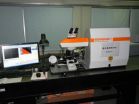(Press-News.org) MANHATTAN, KANSAS — Two Kansas State University biochemists have discovered a family of proteins that could lead to better treatments for Staphylococcus aureus, a pathogenic bacterium that can cause more than 60,000 potentially life-threatening infections each year.
Brian Geisbrecht, professor of biochemistry and molecular biophysics, and Kasra Ramyar, his research associate, are studying S. aureus, which is the cause of increasing common staph infections. Their work appears in the scientific journal Proceedings of the National Academy of Sciences, or PNAS, in the article "Staphylococcus aureus secretes a unique class of neutrophil serine protease inhibitors."
While S. aureus is typically a harmless commensal organism found in the nose and skin of 30 percent of the human population, it can cause serious and deadly infections if it invades deeper tissues.
In their latest research, Geisbrecht, Ramyar and collaborators discovered that S. aureus secretes a family of proteins that prevent neutrophil serine proteases, or NSPs, from functioning — an important finding for understanding how infections are established. Neutrophils — the most abundant type of white blood cells — help prevent serious infections from occurring.
"Neutrophils are like the fire department of the immune system," Geisbrecht said. "They are the first on the scene when a microbial infection tries to take hold."
Neutrophils directly attack pathogens and emit biochemical signals that recruit other inflammatory immune cells to the site of infection when they release NSPs from intracellular granules.
"To our knowledge, Staph is the first example of any bacterium that secretes protease inhibitors specifically to block an aspect of the host immune response that is essential for its removal from the body," Geisbrecht said.
The research also may lead to better treatments for inflammatory conditions, such as emphysema and chronic obstructive pulmonary disease, which are the result of dysregulated neutrophil activation in the lung.
Geisbrecht and Ramyar have closely researched neutrophils because they are the first cells to respond to infections. The biochemists' discovery that that S. aureus secretes a family of proteins — called extracellular adherence proteins, or Eaps — that block NSPs could eventually affect how staph infections are treated in the clinic.
"Understanding this interaction can not only help us design better therapies in the future, but may help make current treatment regimens work better," Geisbrecht said.
Because these Eap proteins prevent neutrophils from working properly, they are essential for S. aureus to establish an infection.
"Our bodies respond vigorously to being invaded by S. aureus, and in order to prevent the infection from spreading, we have an arsenal of soluble molecules and white blood cells," Ramyar said. "That is our immune system, and neutrophils are a vital part of that."
The latest discovery puts a new twist on the past decades of research, which include studies that were done without a detailed molecular insight into how Eap proteins function. Geisbrecht, Ramyar and collaborators are now trying to better understand how their recent findings may affect interpretation of previous research.
"Bacterial pathogens like staph wouldn't be making these proteins if they weren't important to the context of infection," Geisbrecht said. "The bacteria are trying to shut off the inflammatory response and we should be paying attention to how they're doing it."
INFORMATION:
For this project, Kansas State University researchers collaborated with scientists from University Medical Center Utrecht in the Netherlands; Saarland University Medical Center in Germany; University of Veterinary Medicine in Hannover, Germany; and the University of Missouri, Kansas City.
The Kansas State University researchers provided experimental tools, biochemical information and the atomic resolution crystal structure of a complex formed between an S. aureus Eap protein and a human NSP. They received support from the National Institutes of Health.
Biochemists find new treatment options for staph infections, inflammatory diseases
2014-09-02
ELSE PRESS RELEASES FROM THIS DATE:
SMFM releases paper on activity restriction in pregnancy
2014-09-02
WASHINGTON, Sept. 2, 2014—In a new guideline, the Society for Maternal-Fetal Medicine has recommended against the routine use of bed rest in pregnancy.
"There is no evidence that bed rest improves outcomes", says Anthony Sciscione, DO, director of Delaware Center for Maternal and Fetal Medicine and one of the co-authors of the guideline. "However, there is evidence that bed rest can be harmful for moms, babies, and families."
About one in five women are placed on bed rest during their pregnancy. Surveys have shown that both ob/gyns and maternal-fetal medicine specialists ...
How genes link a mother's diet to the risk of obesity in her offspring
2014-09-02
Many research studies have made it clear that a mother's eating habits prior to pregnancy, during pregnancy and during lactation have a profound impact on her offspring and their propensity for developing weight problems, including obesity. However, until now, the mechanisms behind this phenomenon were unclear. According to new research published in the September 2014 issue of The FASEB JournalF, scientists using an animal model found an epigenetic link between a mother's diet and an offspring's risk of future obesity. This link hinges on the blocked expression of a gene ...
Scripps Florida scientists make diseased cells synthesize their own drug
2014-09-02
JUPITER, FL, September 2, 2014 – In a new study that could ultimately lead to many new medicines, scientists from the Florida campus of The Scripps Research Institute (TSRI) have adapted a chemical approach to turn diseased cells into unique manufacturing sites for molecules that can treat a form of muscular dystrophy.
"We're using a cell as a reaction vessel and a disease-causing defect as a catalyst to synthesize a treatment in a diseased cell," said TSRI Professor Matthew Disney.
"Because the treatment is synthesized only in diseased cells, the compounds could provide ...
Mirabegron for overactive bladder: Added benefit not proven
2014-09-02
Mirabegron (trade name: Betmiga) has been approved since December 2012 for the treatment of adults with overactive bladder. In an early benefit assessment pursuant to the Act on the Reform of the Market for Medicinal Products (AMNOG), the German Institute for Quality and Efficiency in Health Care (IQWiG) examined whether this new drug offers an added benefit over the appropriate comparator therapy specified by the Federal Joint Committee (G-BA).
Mirabegron had an advantage with regard to side effects: Dry mouth was less common in comparison with tolterodine. No added ...
Giant garbage patches help redefine ocean boundaries
2014-09-02
WASHINGTON, D.C., September 2, 2014 – The Great Pacific Garbage Patch is an area of environmental concern between Hawaii and California where the ocean surface is marred by scattered pieces of plastic, which outweigh plankton in that part of the ocean and pose risks to fish, turtles and birds that eat the trash. Scientists believe the garbage patch is but one of at least five, each located in the center of large, circular ocean currents called gyres that suck in and trap floating debris.
Researchers from the University of New South Wales (UNSW), in Sydney, Australia, ...
New method for non-invasive prostate cancer screening
2014-09-02
WASHINGTON D.C., Sept. 2, 2014 – Cancer screening is a critical approach for preventing cancer deaths because cases caught early are often more treatable. But while there are already existing ways to screen for different types of cancer, there is a great need for even more safe, cheap and effective methods to save even more lives.
Now a team of researchers led by Shaoxin Li at Guangdong Medical College in China has demonstrated the potential of a new, non-invasive method to screen for prostate cancer, a common type of cancer in men worldwide. They describe their laboratory ...
Scientists create renewable fossil fuel alternative using bacteria
2014-09-02
The development is a step towards commercial production of a source of fuel that could one day provide an alternative to fossil fuels.
Propane is an appealing source of cleaner fuel because it has an existing global market. It is already produced as a by-product during natural gas processing and petroleum refining, but both are finite resources. In its current form it makes up the bulk of LPG (liquid petroleum gas), which is used in many applications, from central heating to camping stoves and conventional motor vehicles.
In a new study, the team of scientists from ...
A handsome face could mean lower semen quality
2014-09-02
Contrary to what one might expect, facial masculinity was negatively associated with semen quality in a recent Journal of Evolutionary Biology study. As increased levels of testosterone have been demonstrated to impair sperm production, this finding may indicate a trade-off between investments in secondary sexual signaling (i.e. facial masculinity) and fertility.
Interestingly, males estimated facial images generally more attractive than females did, suggesting that males may generally overestimate the attractiveness of other men to females.
INFORMATION: END ...
Underwater grass comeback bodes well for Chesapeake Bay
2014-09-02
CAMBRIDGE, MD (September 2, 2014)—The Susquehanna Flats, a large bed of underwater grasses near the mouth of the Susquehanna River, virtually disappeared from the upper Chesapeake Bay after Tropical Storm Agnes more than 40 years ago. However, the grasses mysteriously began to come back in the early 2000s. Today, the bed is one of the biggest and healthiest in the Bay, spanning some 20 square miles. A new study by scientists at the University of Maryland Center for Environmental Science explores what's behind this major comeback.
"This is a story about resilience," said ...
Men who exercise less likely to wake up to urinate
2014-09-02
MAYWOOD, Ill – Men who are physically active are at lower risk of nocturia (waking up at night to urinate), according to a study led by a Loyola University Chicago Stritch School of Medicine researcher.
The study by Kate Wolin, ScD, and colleagues is published online ahead of print in Medicine & Science in Sports & Exercise, the official journal of the American College of Sports Medicine.
Nocturia is the most common and bothersome lower urinary tract symptom in men. It can be due to an enlarged prostate known as benign prostatic hyperplasia (BPH) -- as the prostate ...





